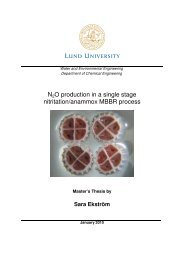Alexander Szabo and Oscar Engle - Svenskt Vatten
Alexander Szabo and Oscar Engle - Svenskt Vatten
Alexander Szabo and Oscar Engle - Svenskt Vatten
You also want an ePaper? Increase the reach of your titles
YUMPU automatically turns print PDFs into web optimized ePapers that Google loves.
2. Waste Water Treatment Ponds Technology<br />
2.1 Introduction to Waste water treatment ponds<br />
Waste water treatment ponds are used around the world for treatment of municipal waste water.<br />
They can offer a good alternative where l<strong>and</strong> prices are low <strong>and</strong> where the climate is beneficial.<br />
Since there is a general relationship between growth rate of bacteria <strong>and</strong> algae that contribute to<br />
the treatment of waste water, pond systems in a warmer climate benefit from high temperatures.<br />
A pond system can be built easily <strong>and</strong> does not require much maintenance. Since it can hold large<br />
quantities of water, it has a good resistance to shock loads <strong>and</strong> hazardous substances that may<br />
enter the system.<br />
A typical arrangement of waste water treatment ponds consists of a primary facultative pond<br />
followed by one or multiple maturation ponds. Under some conditions it is also possible to use an<br />
anaerobic pond before the facultative pond (see Figure 2.1).<br />
Figure 2.1: In this figure three possible arrangements for pond system are illustrated. The first two<br />
series illustrates a primary facultative pond (F) followed by one or two maturation ponds (M). The<br />
third pond series illustrates an anaerobic pond (A) followed by a facultative pond <strong>and</strong> finally a<br />
maturation pond (<strong>Szabo</strong> & <strong>Engle</strong>, 2010).<br />
<br />
<br />
<br />
<br />
<br />
<br />
<br />
16















